Mission speakers M53 floor standing speakers and Mission 77c centre speaker
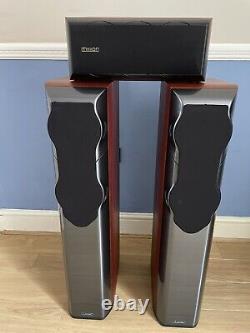
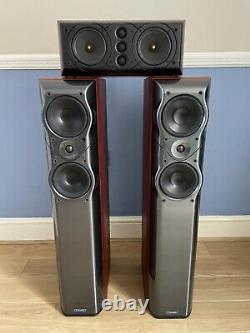
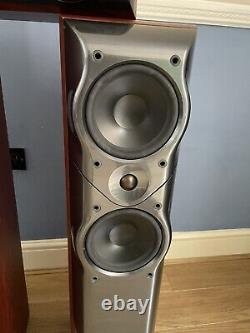
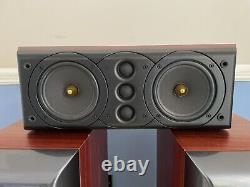
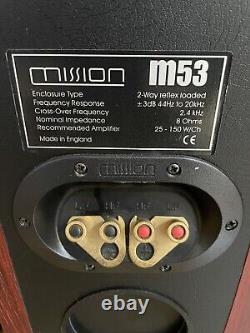
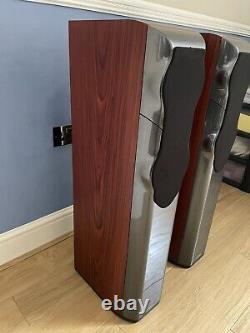
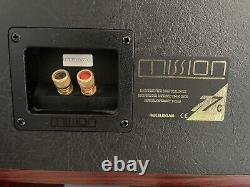

Mission M53 floor standing speakers. Sadly I have to let go of these beautiful speakers which I have had since new. Any one who knows about these speakers will know how good they sound.
Please note strictly collection only and please note they weight approx 19kg each so need a suitable vehicle to transport. If ever a loudspeaker could be described as inscrutable, here it is. Ditto the frequency response, which at 44Hz for the bass (-3dB) hints at what is confirmed by examination, which is that a large part of the bottom part of the enclosure is sectioned off so that it can be used for mass loading rather than to extend the bass response.
At the other end the frequency spectrum, the 20kHz limit shows that the tweeter is not one of the extended bandwidth designs that have become almost ubiquitous this side of the Atlantic in the last couple of years. The 2.4kHz crossover is low enough to offer credibly good dispersion through the upper midband and lower treble, but again without being as radical as some in this respect. Which is quite heavy for its class, but it would be foolish not to take advantage of the mass loading facility (which can and does add very significantly to the Mission's ability to start and stop quickly). But the m53 is not as anonymous as this description makes it seem, even though Mission's own website classes the m5 series of which it is part as'conventional'. Take a look for example at the enclosure, which is solid and well built, and finished in real treewood, which is far from usual at this price level, especially for a loudspeaker built in the UK. Most wood veneered loudspeakers at this price levels are made in China or other low wage areas. The baffle is also unusual, and is clearly a high point of the design, consisting of a full height and extremely deep molding - actually two moldings butt joined together near the tweeter - which is applied over a 38mm thick MDF panel to which the two bass units are bolted.The tweeter by contrast is attached directly to the molding, which is partly foam decoupled from the rest of the enclosure. The idea here is to minimize intermodulation. The shape of the baffle molding is also critical to the m53's design.
Mission has made it as narrow as possible. It bulges out around the bass units, and the sides are smoothed quickly away until they meet the wood side panels, which are themselves shaped inwards to match. There are no sharp edges at all to a front profile that is almost unrivalled for what is essentially a rectangular box loudspeaker in the way it discourages diffraction. The large expenses of molded plastic may not be to everyone's taste, but for what it's worth, I found it grew on me. The quality of finish is very good, the shape has an unusual simplicity and purity, and as a side benefit, the all fixing screws are completely hidden. The loudspeaker is fitted with a push in cloth over frame front cover which is an object lesson its kind, with the complete assembly only about three millimeters thick, to ensure that the hard won acoustic advantages are not thrown away by an acoustically opaque cover. A large area port is fitted on the back panel, along with a cover for the mass loading cavity in the base, and a pair of good quality biwire loudspeaker terminals. The base is fitted with fixing points for carpet piercing spikes. Over the years, Mission has been promiscuous in the range of bass diaphragms and tweeter dome materials it has used.The company has tended to opt for lightweight synthetic materials, often ones that have a low level but residual acoustic signature which once identified are difficult for the ear/brain to tune out. For the bass units in the m53, Mission has identified another new material, which are described as being based on Aramid fibers. Mission supplies no information on this material, or the'microfiber' dome tweeter which is mounted in a gently dished area of the baffle between the two bass units, but it is possible to infer something about them from they way they behave. The short version is that they behave extremely well.
First, the new bass unit material has no obvious audible character, even the relatively benign character that is often ascribed to paper pulp cones. It certainly has none of the'quackiness' often associated with polypropylene and similar polymers.
It appears to be acoustically transparent, and moreover largely free of the overhang that affects some drivers. The tweeter is also clearly a quality item.It is clean and agile, there are no obvious inband resonances, but there is a slight reduction in output at the very highest frequencies, whether to disguise the first HF resonance or for some other reason is not clear. The basic point however is that the moving parts are clearly well sorted individually, and that they mesh together well when used in combination. The loudspeaker has a basic homogeneity whether auditioned from in front, or from off to one side. Any discontinuity in the crossover region is really not detectable by ear when playing music in any of the genres I was able to throw at it over the test period, which has been an extensive one.
The m53 has been in use intermittently, on its own in stereo, and also a part of a complete home cinema system using other m5 series loudspeakers and subwoofer, for many months. It was chosen ahead of other perfectly good alternatives because of its consistency, good audio manners and what is best described as its listenability. An it is this listenability that is the m53's standout feature. There is nothing obvious about it. The drive units don't draw attention to themselves, and the enclosure, which is as important as the so-called active part of any loudspeaker, adds little or no identifiable contributions of its own.
As a result the system is extremely transparent and free of standard box like artifacts. It just sings, like every good loudspeaker should, and because it is a transparent transducer, it is the authentic voice of the electronics components in the system that you hear. If they in turn are as transparent as the loudspeakers, you just get to hear the music.
It's a simple enough deal. The m53 is not beyond criticism. The upper bass has a slight bloom, a region of mild excess. Indeed the bass is not as deep as some loudspeakers this size, though it goes down far enough to pass as full range, and not in need of reinforcement except under exceptional circumstances - such as when used as part of a fully blown home cinema system where a more extended LF is often required to deal with the special demands of many modern movie soundtracks. The m53 is up to the task of reproducing a full Mahlerian orchestra and generating an image that fills its end of a moderately large room given a amplifier rated at 100 Watts or so.The slightly reticent treble mentioned earlier made the Mission seem less incisive than some. If you are looking for the most obviously detailed loudspeaker in its class, the m53 may not be the ideal choice. But it does help balance the relative deficiency at the other end of the frequency spectrum, and this in turn is perhaps one of the reasons why the loudspeaker sounds so well sorted, and why the dynamic capabilities of the loudspeaker are so well proportioned across the band. Last but not least, imagery is excellent. It is not just that the m53 is capable of focusing individual instruments and voices at arbitrary points between the two loudspeakers when set up properly in the listening room.
The image remains in place even when not listening from directly in front. The m53 generates an image of considerable depth, which helps generate an illusion of scale, though you may find it sounds more distant than some. In summary, the m53 is an excellent and affordable low to mid market full range loudspeaker which works extremely well as a stereo loudspeaker, and which can also become the basis of an excellent home theatre system if required. This item is in the category "Sound & Vision\Home Audio & HiFi Separates\Speakers & Subwoofers". The seller is "jata23" and is located in this country: GB.This item can be shipped to United Kingdom.
- Brand: Mission
- Type: Standing Speaker
- Model: M53 & M77c
- Connectivity: Wired

